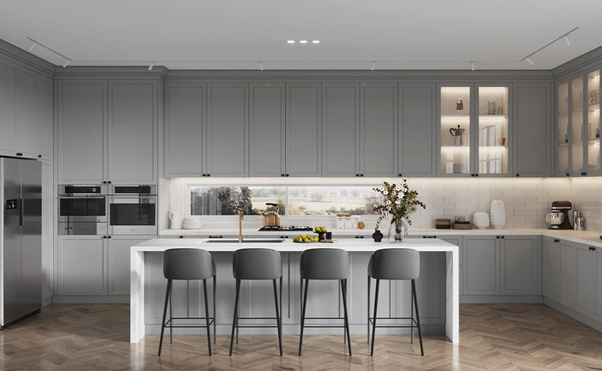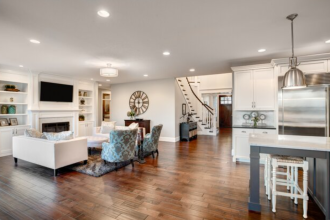Your beautiful kitchen is the heart of your home, and it should reflect your unique style and personality. If you’re tired of settling for mass-produced cabinets that don’t quite fit your vision, it’s time to consider building custom cabinets. Crafting your dream kitchen can be daunting, but with the right guidance, it’s easier than you might think. This step-by-step guide will tell you how to build custom cabinets tailored to your needs and preferences. From choosing the right materials to designing the perfect layout, we’ll cover everything you need to know to create a one-of-a-kind kitchen you’ll love for years. So whether you’re a DIY enthusiast or looking to hire a professional, read on to discover how to make your dream kitchen a reality.
- Benefits of Custom Cabinets
- The Planning Stage: Measuring and Designing Your Cabinets
- Choosing the Right Materials for Your Custom Cabinets
- Building Your Custom Cabinets: Step-by-Step Guide
- Installing Your Custom Cabinets
- Custom Cabinet Design Ideas and Inspiration
- Hiring a Professional vs. DIY: Pros and Cons
- Conclusion
Benefits of Custom Cabinets
Custom cabinets offer many benefits over pre-made, off-the-shelf cabinets. First and foremost, custom cabinets are tailored to your specific needs and preferences, ensuring that they fit perfectly in your kitchen and provide the required storage solutions. With custom cabinets, you have complete control over the design, materials, and finishes, allowing you to create a truly one-of-a-kind kitchen that reflects your unique style.
In addition, custom cabinets are typically made from higher quality materials and construction techniques than mass-produced cabinets. It means they are more durable and long lasting and will stand up to the wear and tear of daily use. Finally, custom cabinets can add value to your home, as potential buyers see them as a desirable feature.
The Planning Stage: Measuring and Designing Your Cabinets
Before you begin building your custom cabinets, planning out the design and layout is essential. It involves measuring your kitchen space, considering obstacles like walls, windows, and doors, and determining the optimal cabinet configuration.
To start, measure the length and width of your kitchen and the height of your ceiling. Next, take note of any obstacles or features that may affect the placement of your cabinets, such as electrical outlets, plumbing fixtures, and windows. Once you have these measurements, you can begin designing your cabinets.
Many software programs and online tools can help you create a 3D model of your kitchen, allowing you to experiment with different cabinet configurations and layouts. Alternatively, you can hire a professional designer to create a custom design.
Choosing the Right Materials for Your Custom Cabinets
When building custom cabinets, your chosen materials are just as important as the design. Various materials are available, each with its unique advantages and drawbacks. Some of the most common cabinet materials used for custom cabinets include:
- Wood: Wood is a classic choice for custom cabinets, as it is durable, versatile, and adds warmth and character to any kitchen. Many different types of wood are available, each with its own texture, grain, and color.
- MDF: MDF, or medium-density fiberboard, is a composite material made from wood fibers and resin. It is a popular choice for custom cabinets, as it is affordable, easy to work with, and can be painted with many colors or stained to match any décor.
- Plywood: Plywood is another popular choice for custom cabinets, as it is strong, lightweight, and resists warping and cracking. It is also available in various thicknesses and grades, allowing you to choose the perfect material for your project.
- Metal: Metal cabinets are a sleek and modern choice for custom kitchens, offering durability and a unique aesthetic. Stainless steel is the most popular metal used for cabinets, as it is resistant to rust and corrosion.
Building Your Custom Cabinets: Step-by-Step Guide
Once you have designed and selected the materials for your custom cabinets, it’s time to start building. While the exact process will depend on the design and materials you have chosen, here is a general step-by-step guide to building custom cabinets:
- Cut the pieces: Cut the cabinet pieces to the desired size and shape using a table saw or circular saw.
- Join the pieces: Using quality wood glue and clamps, join your cabinet pieces together. You may also want to use pocket screws or dowels for added strength.
- Install the shelves: Cut and install the shelves inside the cabinet using brackets or cleats.
- Add the doors and hardware: Cut the doors to size and install them using hinges. Add the hardware, such as knobs and pulls, to complete the look.
- Sand and finish: Sand the cabinet surfaces smoothly and apply the finish you choose, such as paint or stain.
Installing Your Custom Cabinets
Once your custom cabinets are built and finished, it’s time to install them in your kitchen. It is a job best left to professionals, requiring experienced skill for precise measurements and careful installation techniques. A professional installer will ensure that your cabinets are level, secure, and properly aligned and adjust if needed to ensure a perfect fit.
Custom Cabinet Design Ideas and Inspiration
When it comes to designing your custom kitchen cabinets, the possibilities are endless. Here are some ideas and inspiration to get you started:
- Add glass panels to your cabinet doors for a modern touch.
- Incorporate pull-out drawers and shelves for easy access and organization.
- Use a mix of open shelving and closed cabinets for a unique look.
- Choose bold colors or patterns for your kitchen cabinets to make a statement.
- Install lighting inside your cabinets to showcase your dishes and glassware.
Hiring a Professional vs. DIY: Pros and Cons
Deciding whether to hire a professional or DIY your custom cabinets is a personal choice that depends on your skill level, budget, and time constraints. Here are two options’ pros and cons:
Hiring a Professional
Pros:
- Professional installers have the experience and expertise to ensure a perfect fit and finish.
- Professionals can access specialized tools and equipment that may be expensive or difficult to obtain.
- Hiring a professional cabinet maker can save you time and reduce the risk of costly mistakes.
Cons:
- Hiring a professional can be expensive and may not fit within your budget.
- When hiring a professional, you may have less control over the design and materials.
DIY
Pros:
- DIY allows you to have complete control over the design and materials used.
- DIY can be more affordable than hiring a professional, especially if you already have the necessary tools and equipment.
- DIY can be a rewarding and satisfying experience and can help you develop new skills.
Cons:
- DIY requires a certain level of skill and experience and may not be suitable for everyone.
- DIY can be time-consuming, especially if you are new to the process.
- DIY risks mistakes and errors, which can be costly to fix.
Conclusion
Building custom cabinets is a great way to create a one-of-a-kind kitchen that reflects your unique style and personality. Following the above steps and tips, you can design and build custom cabinets tailored to your specific needs and preferences that provide years of beauty and functionality. Whether you hire a professional or DIY your cabinets, the result will be a kitchen you’ll love for years to come.














